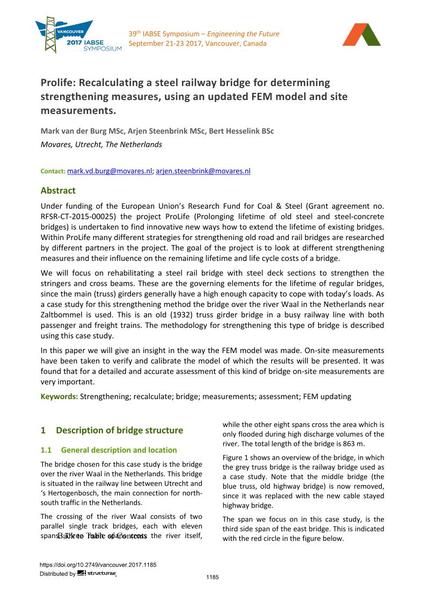Prolife: Recalculating a steel railway bridge for determining strengthening measures, using an updated FEM model and site measurements.

|
|
|||||||||||
Bibliographic Details
| Author(s): |
Mark van de Burg
(Movares, Utrecht, The Netherlands)
Arjen Steenbrink (Movares, Utrecht, The Netherlands) B. H. (Bert) Hesselink (Movares, Utrecht, The Netherlands) |
||||
|---|---|---|---|---|---|
| Medium: | conference paper | ||||
| Language(s): | English | ||||
| Conference: | IABSE Symposium: Engineering the Future, Vancouver, Canada, 21-23 September 2017 | ||||
| Published in: | IABSE Symposium Vancouver 2017 | ||||
|
|||||
| Page(s): | 1185-1192 | ||||
| Total no. of pages: | 8 | ||||
| Year: | 2017 | ||||
| DOI: | 10.2749/vancouver.2017.1185 | ||||
| Abstract: |
Under funding of the European Union’s Research Fund for Coal & Steel (Grant agreement no. RFSR-CT-2015-00025) the project ProLife (Prolonging lifetime of old steel and steel-concrete bridges) is undertaken to find innovative new ways how to extend the lifetime of existing bridges. Within ProLife many different strategies for strengthening old road and rail bridges are researched by different partners in the project. The goal of the project is to look at different strengthening measures and their influence on the remaining lifetime and life cycle costs of a bridge. We will focus on rehabilitating a steel rail bridge with steel deck sections to strengthen the stringers and cross beams. These are the governing elements for the lifetime of regular bridges, since the main (truss) girders generally have a high enough capacity to cope with today’s loads. As a case study for this strengthening method the bridge over the river Waal in the Netherlands near Zaltbommel is used. This is an old (1932) truss girder bridge in a busy railway line with both passenger and freight trains. The methodology for strengthening this type of bridge is described using this case study. In this paper we will give an insight in the way the FEM model was made. On-site measurements have been taken to verify and calibrate the model of which the results will be presented. It was found that for a detailed and accurate assessment of this kind of bridge on-site measurements are very important. |
||||
| Keywords: |
bridge strengthening assessment measurements recalculate FEM updating
|
||||
